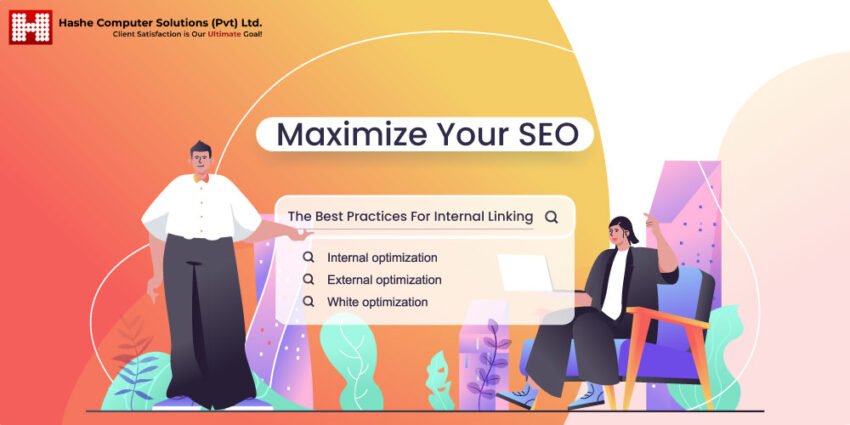
External links often get the most attention when it comes to improving search engine ranking; however, internal links are as vital
Internal links are like the foundation for both on-page optimization and SEO since they facilitate Google in discovering, crawling, and indexing your website’s pages.
Without thoughtful internal linking, pages on your website may be dormant, isolated from Google, and without organic traffic. Even worse, an inefficient internal link structure can degrade user experience by making it challenging for users to locate the sites they require, which encourages exits.
You may improve the number of pages that appear in search results and drive traffic by carefully using internal linking. Furthermore, you can also use them to transfer page authority from one page to another.
In this article, we will see the best practices of effective internal linking so you may rank more pages, rank them higher, and ensure both users and search engines can always locate what they need. So, let’s get started!
What are internal links?
Internal links are clickable hyperlinks that take users from one page of your website to another. As the name implies, internal links, in contrast to external links, remain on the same domain and link to inside pages.
For instance, the navigation on your website uses internal linking to direct users and search engine crawlers to other pages on the same website.
Why are internal links crucial for SEO?
Aside from the fact that Google searches the internet via links, there are four significant search engine optimization advantages to quality internal linking, which render it a must-have for every strong SEO plan.
1. Enhance user experience
Effective internal linking leads to an enhanced user experience: the simpler it is for visitors to access pertinent pages, the more effortless their experience will be.
Poor internal linking results in a poor site structure and a negative user experience: less time spent on the site, higher bounce rates, fewer pages per visit, lower conversions, and more dissatisfaction.
2. Increase ranking
Internal links are backlinks for pages within your site, so think of them similarly to how you might think of a backlink. Internal links convey page authority from one website to another, akin to backlinks, which in turn helps improve SERP rankings.
3. Increase indexing
Search engines like Google only have a limited amount of “crawl budget” to spend on websites. Google’s algorithms can only crawl and index a specific number of pages from your website in a particular amount of time.
Most websites will include pages that are all within a particular price range. However, many pages (100+ pages) might not be available on larger websites. Therefore, not every page will be indexed.
Internal linking makes deep pages on your website easier for Google to identify, prioritize, crawl, and index so that more of them can be indexed while staying within your budget.
4. Increase conversions
Calls-to-action (CTAs) assist consumers in progressing from one step of their journey to the next. They encourage action and aid visitors in completing tasks more quickly.
Moving from rankings to revenue is the final objective of SEO. And you can’t achieve it without strategically placed CTAs.
Top 9 Best Practices for Building Internal Links
Here are ten best practices to help you build and optimize your internal links.
1. Make A Lot of Content
You have to create numerous internal pages with high-quality content if you want to have many internal links throughout your website. Your website will have enough internal linking chances to take advantage of if it has a lot of content, so you won’t need to worry about using the silo technique or complicated content layers to create an effective internal linking structure.
2. Improve Rankings by Linking High Authority Pages to New
The Authority Transfer approach is a crucial and successful strategy for distributing link authority to a website’s most important SEO-driven pages. You can use efficient tools like Ahrefs to find such pages and add internal links to them. Enter your domain into Ahrefs, then click “Best by Links” under “Pages” and sort by “RDs.” It is one of the most effective techniques to increase the authority of such SEO-driven pages.
3. Utilize the anchor text you want to rank for.
When it comes to images, you should use anchor texts rather than image links to maintain the internal linking theme of the content. Ensure the alt tags are written correctly and accurately explain each image if you wish to link to them. To prevent your links from appearing spammy, utilize natural and unoptimized sentence fragments as your linking anchor texts.
4. Link Deep
There are two types of internal linkages that you should avoid when developing them. The first is to create links to your website’s homepage. Because your homepage will already have numerous links directed to it, focus on boosting internal sites by interlinking them instead of adding more.
Another typical error is linking to the “Contact Us” page to include a call to action (CTA) at the end of their posts. That is not advisable unless it is essential. In most cases, the homepage will already link to these pages in its primary navigation bar, so avoid linking to them and instead link to those found deep within the structure.
5. Make Certain Links Are Contextual
The fundamental objective of an internal linking strategy is to provide a better user experience; all other benefits follow afterward. Google favors sites that seek to create a positive user experience.
When you add internal links to a piece of content, you notify the user that the linked website will be relevant to the context of that specific piece of content.
As a result, it benefits both you and your target users. Users will discover more to read, and your rating will improve due to the website’s efficient internal linking.
6. Employ Suitable Links for Internal Linking.
When constructing an internal link, verify that the page you are linking from has material relevant to the website you are linking to.
For instance, your online medical business may feature a webpage discussing the advantages of wearing sunscreen. You can include a link to a product page offering a list of sunscreens on this page. However, you cannot link to a page selling headache medications.
7. Use a reasonable amount of internal links.
There is no requirement for your website to have extensive internal links. The amount of internal links you can create for your website is not subject to any known restrictions. You can include 2–5 links in each post based on the length. For an article of 1500 words, five internal links are sufficient. Additionally, ensure that the links are dispersed widely throughout the text.
8. Avoid utilizing the same anchor texts for two distinct pages.
Using the same anchor text on two different pages confuses Google and could lead it to believe they both contain content on the same subject. To prevent confusion, utilize descriptive anchor texts on web pages.
9. Place links towards the top of your page.
Internal links positioned higher on a page lengthen user engagement and lower bounce rates. When you provide an internal link at the opening of an article, readers will have something to look at immediately. As a result, they will spend more time on your website. Of course, you should place internal links across the body of your webpage, but it never hurts to add one or two links at the top.
10. Utilize internal links to assist in indexing.
Google typically finds and indexes all of a website’s significant pages. If you have numerous web pages beyond your crawl budget, Google might only be able to index a portion.
Best practices for internal linking make it simpler for Google to find web pages to index, especially those tucked away deep inside the architecture of your site.
Wrapping Up!
By employing these efficient internal linking techniques, you can conveniently improve the internal linking framework of your website without encountering difficulties or sacrificing a straightforward site structure.
You can increase your website’s SEO by adhering to internal linking best practices throughout the site! We hope that this article will be helpful to you in these endeavors!
If you are looking for ways to digitize your marketing endeavors, look no further! Hashe is one of the leading digital marketing agencies that enact and implement the best growth-driven digital marketing strategies guaranteed to boost your customers, sales, and growth! Contact us today!
Keep following us for more tech news! Check out our Social Media Pages
Was this helpful?
Last Modified: June 26, 2024 at 7:38 am
152 views















